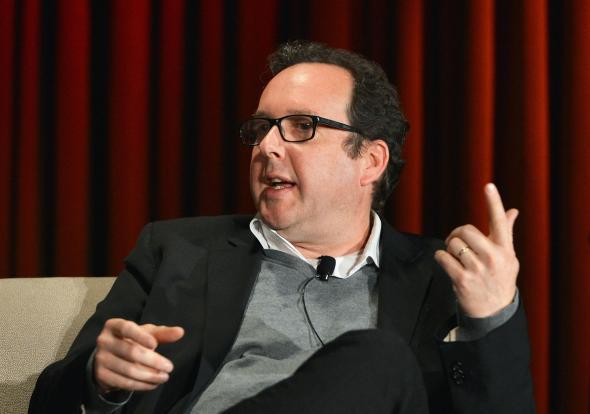Readers of the New York Times’ review of Noah may have noticed something stylistically unusual about its explanation of the film’s PG-13 rating: “And every living substance was destroyed which was upon the face of the ground, both man, and cattle, and the creeping things, and the fowl of the heaven; and they were destroyed from the earth: and only Noah remained alive, and they that were with him in the ark.” If that sounds familiar, it’s because it’s Genesis 7:23.
Quirky ratings descriptions are something of a tradition at the Grey Lady. When I asked A.O. Scott, the Times movie reviewer, about his biblical interpretation of Noah’s rating, he told me that it’s always been the reviewer’s responsibility to explain the MPAA decision, and that the Times critics strive to be creative with them. In addition to being humorless, the MPAA’s official explanations are not always that informative—for example, Noah’s rating is justified as being “for violence, disturbing images, and brief suggestive content”—so why not have a little fun with them? Scott occasionally forgets to include one, and consequently gets a note from his editor reminding him, but with the Noah review he had dutifully read the chapters in Genesis in anticipation of the movie and found the “every living substance” verse particularly fitting. (It’s the first time Scott can remember that Scripture has appeared in one of these endnotes.)
Many Times reviewers now use the rating explanation as a way to get in one last piece of criticism, and to critique the MPAA’s rating system itself. Scott noted that he sees movies where entire cities are destroyed and millions of people are killed, but the movie gets a PG-13 rating because there’s no blood. On the other end of the spectrum, some indie movies get an R rating just because teenage characters smoke pot or have sex, common occurrences in many young adult novels. Of late, the New York Times ratings description has also become a poetic review in its own right and can be read as a TL;DR version that, because of its brevity and wit, is prime fodder for a tweet.
While Scott thinks Jeannette Catsoulis is the master of the form—and her notes are pretty excellent—here at Slate we’re very fond of Scott’s heroic efforts to clarify why Blue Is the Warmest Color received an NC-17 rating, and his inability to explain The Paperboy’s R rating. Scott couldn’t come up with a favorite off the top of his head—though he was particularly proud of last week’s “Gallic behavior and Anglo-Saxon words” for Le Week-End—but there are various Tumblrs devoted to his genius. Herewith, some of our favorite MPAA ratings as explained by A.O. Scott.
Much of Scott’s best work has to do with how children might understand a movie:
“Adore” is rated R (Under 17 requires accompanying parent or adult guardian). Sure, bring your kids. They’ll have lots of good questions.
“The Squid and the Whale” is rated R (Under 17 requires accompanying parent or adult guardian). Adults must be protected from the uncomfortable insights it may offer their children—especially those between ages 13 and 16—into the nature of parenthood.
“Take Shelter” is rated R (Under 17 requires accompanying parent or adult guardian). Children will hear some bad words, while grown-ups confront their own deepest fears.
“The Simpsons Movie” is rated PG-13 (Parents strongly cautioned). It has what the official advisory describes as “irreverent humor throughout” as well as brief cartoon nudity. Won’t somebody think of the children?
Other times, they serve as in-jokes about the film’s makers or source material.
“Kill Your Darlings” is rated R (Under 17 requires accompanying parent or adult guardian). The best minds of their generation, with foul mouths and unruly appetites.
“O Brother, Where Art Thou?” is rated PG-13 (Parents strongly cautioned). It has a good deal less violence, obscenity and sex than Homer’s “Odyssey,” and not nearly as much as the average American folk song.
“Much Ado About Nothing” is rated PG-13 (Parents strongly cautioned). It’s filthier than your English teacher let on.
“Knocked Up” is rated R (Under 17 requires accompanying parent or adult guardian). It finds abundant humor in the details—and the very existence—of the human reproductive system.
“Fantastic Mr. Fox” is rated PG (Parental guidance suggested). It has danger, sorrow and an awareness of mortality.
“Crazy Heart” is rated R. (Under 17 requires accompanying parent or adult guardian.) Drinking, smoking, sex and swearing. If that ain’t country …
“The Tree of Life” is rated PG-13 (Parents strongly cautioned). Birth, death, the end of the world.
“Fill the Void” is rated PG (Parental guidance suggested). Modesty is respected.
“Wreck-It Ralph” is rated PG (Parental guidance suggested). Some crude language and violence enacted by (and visited on) digitally created replicas of digitally created replicas of imaginary beings.
More often than not, they’re just fun in their own right.
“World War Z” is rated PG-13 (Parents strongly cautioned). Epic slaughter of the already dead; more discreet and selective killing of the sympathetically alive.
“Pacific Rim” is rated PG-13 (Parents strongly cautioned). The usual wanton, carefully edited slaughter of untold millions, and a lot of Kaiju blood.
“Total Recall” is rated PG-13 (Parents strongly cautioned). It has action violence, brief nudity and swearing, though more of that is likely to come from Philip K. Dick fans in the audience.
“Win Win” is rated R (Under 17 requires accompanying parent or adult guardian). Language familiar to anyone who has driven in New Jersey.
Sadly, The Aristocrats wasn’t rated.
